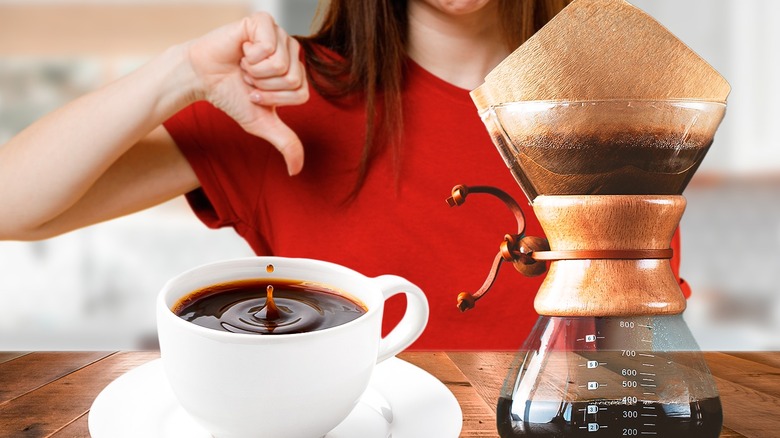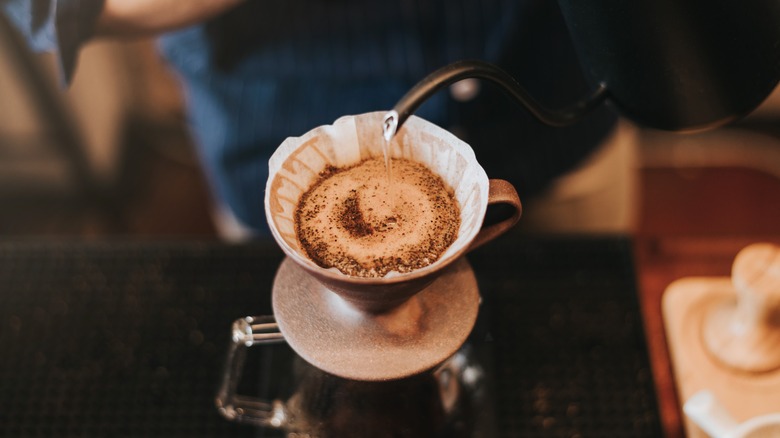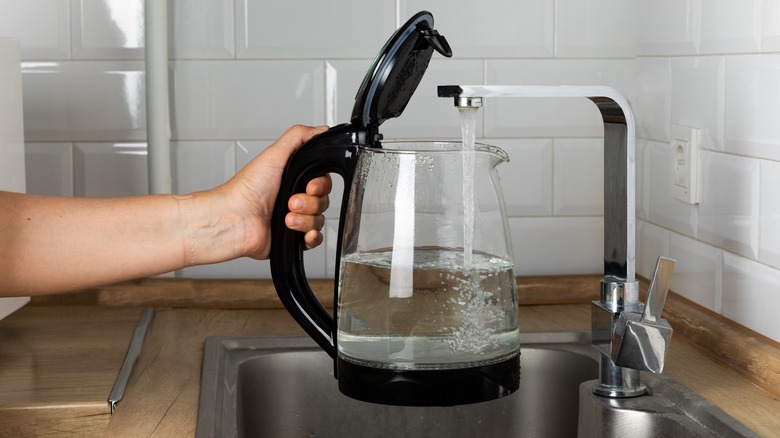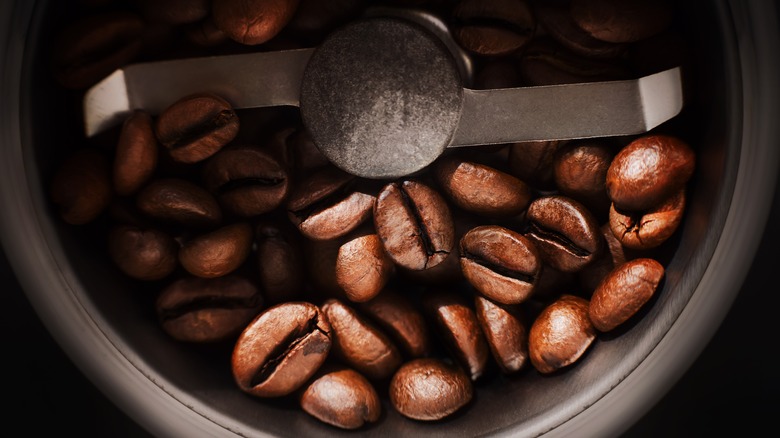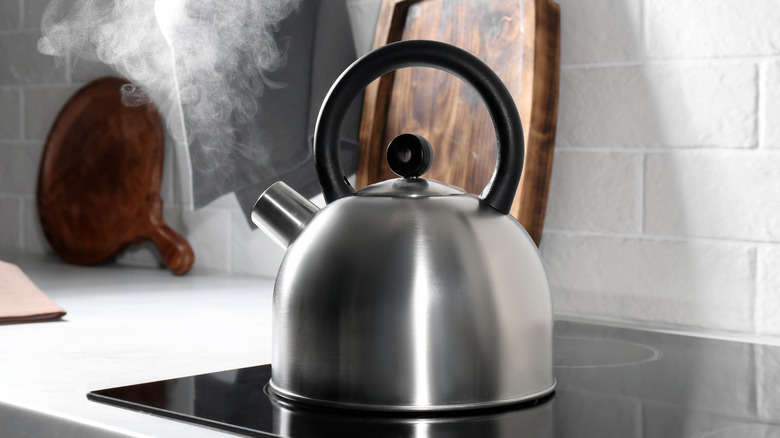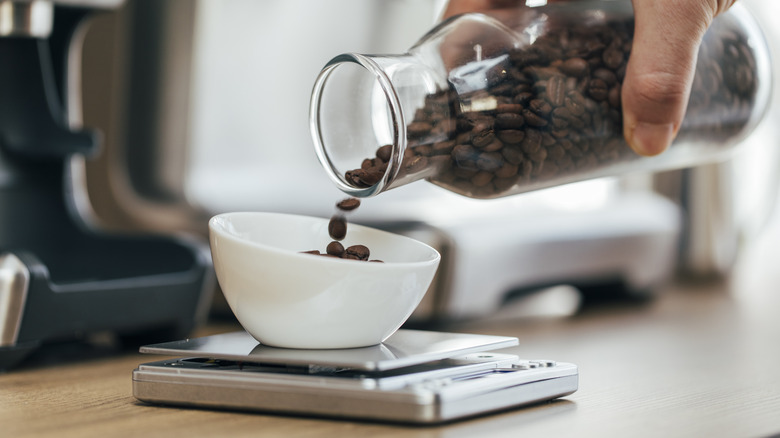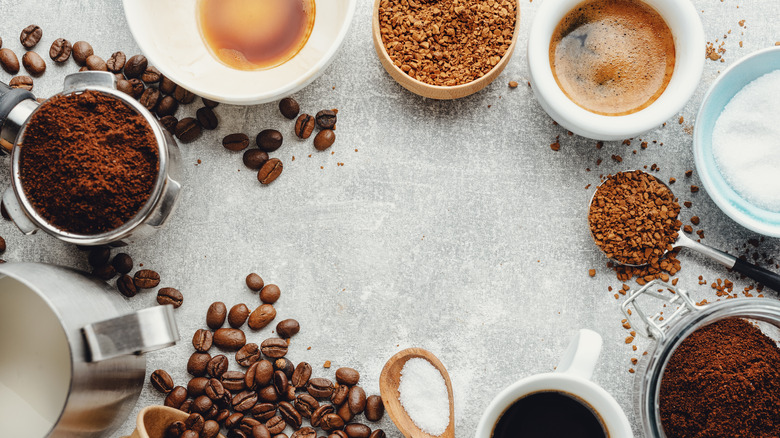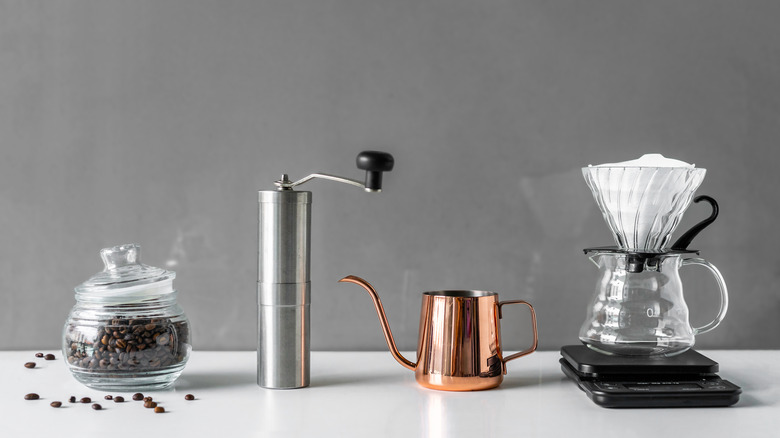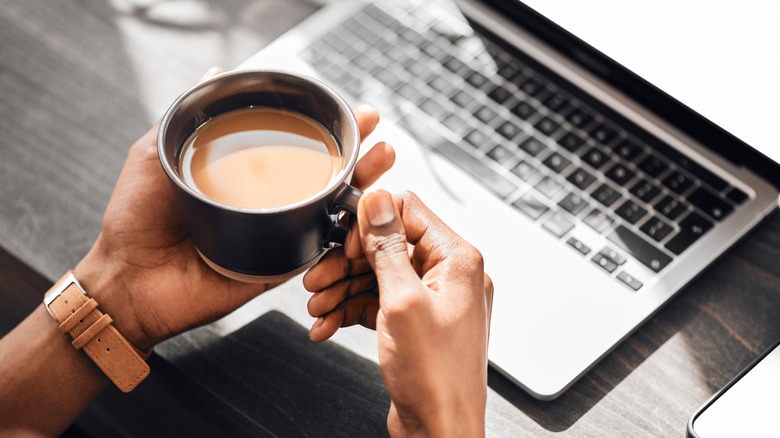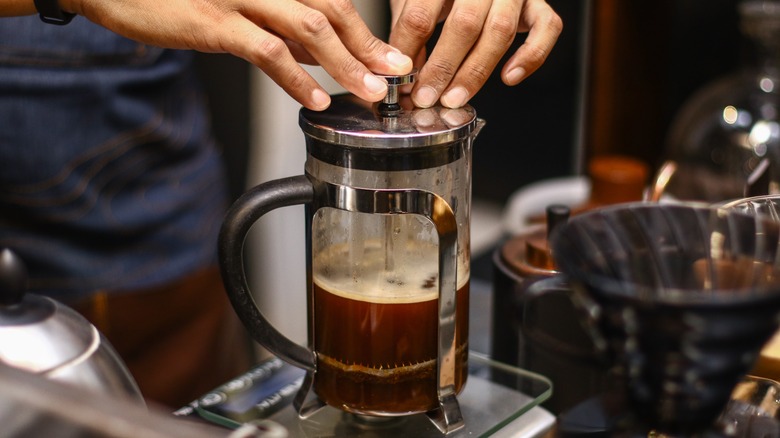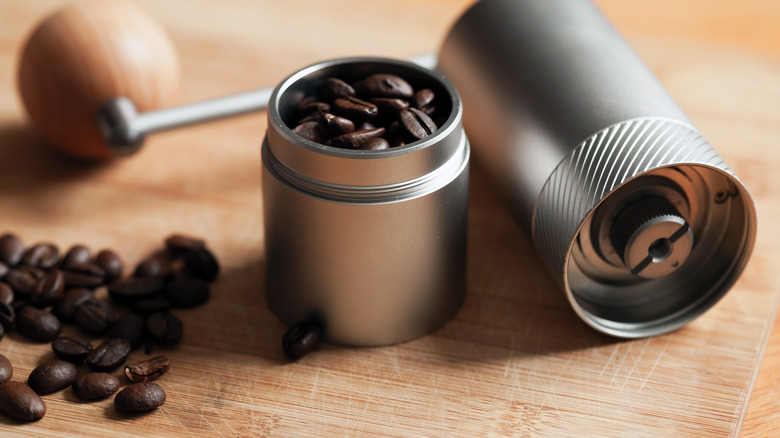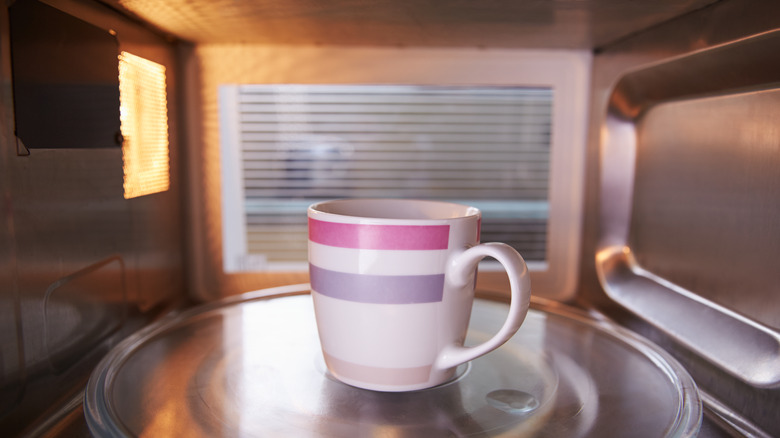11 Reasons Your Freshly Brewed Coffee Tastes Bad
Have you ever made a cup of morning joe, only to take that first sip and, to your dismay, nearly gagged at how bad it was? We've all been there. But for those of us who are not coffee experts, our mistakes can often be mystifying to us. To better understand what makes your homemade cup of coffee taste terrible and how to avoid the cardinal sins of coffee making, we talked to a coffee expert.
Sarah Lambeth, a South Alabama native, is the founder of Pretty Coffee Roasting and co-founder of Whatever Coffee, located inside Stein's Deli in the Lower Garden District of New Orleans, Louisiana. Sarah is one of the few female roasters in the United States with an almost all-female supply chain. She's an expert in all things coffee and was a barista judge in the 2022 United States Coffee Championship. Even more, she's rather open about her days spent trying to perfect her craft.
"I always love reflecting back on a time when I also made s***** coffee because I have made a ton of trying to get it right," Lambeth said. "Pick one variable to change at a time with any brewing method. Make a bad cup? Pick one to change — grind, ratio, time — adjust accordingly as you brew again and again."
You can order Sarah's beans from the Pretty Coffee Roasting Instagram page, and visit Whatever Coffee inside of Stein's Deli, 2207 Magazine Street, New Orleans.
Over- or under-extracting
The word "extraction" is a key term in coffee brewing that refers to the process of flavor compounds in coffee — such as acids, oils, and sugars — dissolving in water. In the dissolution process, these compounds are extracted into the water medium to create liquid coffee. Aiming for optimal extraction is key to making a delicious cup of coffee every time. The extremes of extraction — either too much or too little — are what put unpleasant or diluted flavors in your cup of coffee.
"Weak coffee is the worst," said Sarah Lambeth. Striking a balanced extraction is key to this coffee expert. "It's a matter of brewing, grinding, dialing into each coffee to tap into the dope-ness within."
Over-extraction is when too much dissolution of coffee compounds occurs in the water, resulting in an unpleasantly strong and bitter brew. If your coffee tastes this way, there are several mistakes you may have made when making it. Your water may have been too hot, your grind too fine, your brew time too long, or you may have used too much coffee.
On the other hand, under-extraction is when not enough solubles are dissolved into the water, making for a weak and sour taste. Causes for under-extraction are opposite those of over-extraction and can be any of the following: using too-cool water, too-large grind size, too-short brew time, or too-little coffee. A telltale sign of under-extracted coffee is a light, thin body combined with a weak taste.
Using tap water
According to Sarah Lambeth, one immediate reason for fresh coffee tasting bad is tap water. There is a reason enthusiasts opt for specialized filters or bottled water to brew their coffee. Tap water introduces many variables into brewing that may, depending on environmental factors, affect flavor. One example is hardness, the measure of the concentration of minerals such as calcium and magnesium in water. Hard tap water can lead to accidental over-extraction, resulting in bitter coffee. Conversely, soft water may under-extract, causing the coffee to taste flat and under-flavored.
The pH level of tap water varies greatly by region and can influence the extraction process. Coffee extraction is optimal when the water is in the slightly acidic to neutral range, with a pH of 6 to 7. Extremely acidic or basic tap water can affect the solubility of coffee compounds, leading to undesirable flavors.
Tap water might also contain impurities or undesirable odors that can impact the flavor of coffee. Chlorine is often added to tap water by municipalities to disinfect it and can give coffee an unpleasant taste. If you must use tap water, allow it to sit uncovered for 24 hours to let chlorine dissipate. Boiling for 15 minutes can help.
Some companies offer water filters specifically designed for brewing coffee. These filters aim to provide an ideal mineral balance for extraction. Third-wave coffee enthusiasts often use these filters for precision in water quality, but basic activated carbon filters can be just as good.
Using a blade grinder
If you're still using a single-blade grinder to grind your coffee beans, do yourself a favor and reserve it for grinding whole spices instead. Per Sarah Lambeth of Pretty Coffee Roasting, it could be one reason why your fresh coffee tastes bad.
When using a blade grinder, it is impossible to get consistent, uniform-sized coffee grounds. Blade grinders produce an uneven grind size because they don't actually grind coffee at all — rather, they essentially chop coffee beans into pieces, creating different-sized debris. This means that the pieces are extracted in the water medium at different rates. Coffee that's chopped too small can be easily over-extracted, while too-large pieces will not be extracted fully.
Different-sized coffee pieces also mean inconsistent brews. It's challenging to reproduce the same grind size for consistent brewing results with a blade grinder, making it much more difficult to fine-tune your brewing parameters. Finally, blade grinders can generate heat due to the friction created during the grinding process. Heat can negatively impact the flavor of the coffee by altering the oils and compounds in the beans.
If you're going to grind your own coffee beans, invest in a burr grinder. Burr grinders crush the coffee beans between two rotating abrasive surfaces, providing a more consistent grind size and avoiding the issues that come along with blade grinders. With consistently sized and unaltered coffee grounds, you can focus your efforts on controlling more of the variables holding you back from brewing your best self.
Your water is too hot
Water is another crucial factor in coffee brewing that is rather simple to rule out as a variable. If you pour scalding-hot water over your coffee grounds without ensuring it is within an optimal temperature range, you risk imparting unwanted flavors into your final product.
Higher water temperatures mean over-extraction, which occurs when the water extracts compounds from the coffee grounds too quickly and in excessive amounts. Over-extracted coffee means a brew that tastes bitter, astringent, and really unpleasant to drink. These bitter or sour tastes could also be a result of the hot water literally burning the coffee grounds, giving the coffee a charred flavor.
Furthermore, there are a ton of nuanced flavor notes in coffee that can only be tasted properly at certain temperatures. Brewing coffee at too high of a temperature can overwhelm the senses, making it almost impossible to taste all of the individual unique characteristics of the brew.
The best coffee is made with water between 195 F (90 C) and 205 F (96 C). To ensure your water is within range, you've got a few options. Consider investing in a kettle with a built-in thermometer and temperature control settings for seamless ease when heating your water. If you're not keen on getting more gadgets for your brewing, you can opt for the more manual method of pre-boiling and waiting until the temperature of your water reaches this range by using a thermometer of your own.
Using the wrong ratio of water to coffee
Your water-to-coffee ratio is vital to the strength, body, and flavor of the coffee you make. Since it goes hand-in-hand with extraction, it's important to strike a careful harmony.
"Make a bad cup? Pick one to change — grind, ratio, or time," said Sarah Lambeth. "Adjust accordingly as you brew again and again." Some guides recommend a "golden ratio" — 1 to 2 tablespoons of ground coffee for every 6 ounces of water. That said, there is no one-size-fits-all ratio. Your proportions will depend on your brewing method and personal preferences and might take some trial and error to perfect.
First, you'll want to determine the right proportions of water to grounds for your desired method of coffee brewing. Espresso characteristically uses a smaller ratio of coffee to water, typically around 1:2, while higher-volume brewing methods, such as pour-over, start around 1:15. Further, you might have to adjust your ratio depending on the size and time of your brewing method. For example, cold brewing coffee uses a higher ratio because extraction takes much longer using cold coffee and very coarse grounds.
Start experimenting by tweaking ratios for your preferred brewing method or methods until you find one that works for you, and then work toward perfecting your technique. You might choose to use a gram scale to maintain precision in your measurements. Aiming for consistency with your measurements will behoove you when trying to replicate that perfect cup every time you make coffee.
Brewing all coffees the same
Not all coffee is created equal. Sarah Lambeth said a common mistake she sees novice homebrewers make is "brewing all coffees the same and being confused why they come out different." Factors like bean origin, roast level, processing method, and flavor profile will all influence how you grind and brew, giving all coffee its own unique personality of sorts.
"Processing and elevation can make a huge impact on density in the bean," Lambeth said. "So when you change coffees, but keep everything consistent and it brews differently, people can get frustrated or think the coffee is 'bad.'" Rather, she advises home brewers to pay attention to the nuances of their chosen coffee and act accordingly.
Processing is the method by which roast-ready green coffee beans are produced from harvested coffee cherries. Each processing method — washed, natural, honey, anaerobic, semi-washed — affects the moisture level of your beans. The moisture levels then affect how each batch of beans should be ground and brewed. Shop around for beans with an optimal level of moisture to ensure a well-balanced and full-flavored brew.
Believe it or not, even the elevation at which your coffee beans were grown can affect how you might choose to brew your beans. Generally speaking, the higher elevation at which the beans were grown, the more dense they tend to be. Denser beans tend to benefit from coarser grinds, and less dense beans from finer grinds.
Using the wrong tools
While you may see baristas of the world sporting a flex-worthy arsenal of gadgets and doohickeys, our expert believes you really don't need to break the bank to make a solid cup. Just a few particular items can give you the power to never make a bad cup of coffee again.
"Gram scale, burr grinder, water filter, good beans. (You are) literally unstoppable if you have at least three of these four," Sarah Lambeth said.
Because much of coffee brewing requires precision and consistency to achieve the best results time and time again, a gram scale allows the coffee enthusiast to measure their grounds and water down to a hair. Using a gram scale when portioning out ground beans and again when pouring water over them gives you unparalleled transparency and control over the measurements you make and, therefore, the all-important water-to-coffee ratio.
Your choice of coffee beans is just as important as the hardware you choose to process them. Choosing good coffee beans means making sure the beans you buy are fresh, properly processed, and sourced from reputable roasters. Just as well, grinding beans fresh for each brew will also help maintain the quality of your beans, as pre-ground beans will stale at a much faster rate than whole. "For ground coffee, if I ground up some beans for a pour-over, letting them sit on the counter or even wrapped back up, time is ticking," Lambeth said. "The beauty in the aromatics is breaking down."
Skipping the research
As with any respectable trade or hobby, the world of coffee has an encyclopedia of research and information behind it. According to Sarah Lambeth, learning the lingo of the trade will be very helpful in addressing why your fresh coffee tastes bad. "There are lots of charts and info online to help guide homebrewers," she said. "A bad cup can be bad in so many directions, so learning some language of extraction is super helpful."
Beyond over-extraction and under-extraction, getting acquainted with other important vocabulary terms — such as total dissolved solids, bloom, percolation, dialing-in, channeling, and equilibrium — can help flatten the learning curve by putting words to each step of the brewing process.
For the optical learner, charts can be helpful in visualizing the nitty-gritty under the surface of the brewing process. The Coffee Brewing Control Chart, for example, is a visual tool that plots key brewing variables on a graph to help better control them during the brewing process.
For the avid readers out there, there has been a wealth of contemporary books published on coffee, from the growing and harvesting process to the liquid gold inside your cup. Remember: knowledge is power. The more you know about the craft of coffee, the better chance you have at making a delicious batch.
Leaving your French press coffee in the brewer
When asked about some cardinal sins of coffee brewing, Sarah Lambeth pointed out the commonality of brewing a French press coffee and leaving the coffee in the carafe without decanting into a serving vessel. "This is common, and the coffee keeps brewing, so whoever gets the last cup after it is not only silty but over-extracted," she said.
If the water in the French press remains in contact with the grounds for an extended period of time, the coffee will rapidly become bitter and unpleasantly strong. The optimal brew time for a French press is only about 4 to 5 minutes when using a coarse grind, which is generally the ideal size for this method. Your best bet when using a French press is to set a timer, press the coffee, and pour the entire contents out into another vessel to reserve for drinking now or later.
Putting flavored or extremely-dark roasted (i.e. French roast) coffee in a grinder
For our expert, another reason why your fresh coffee tastes bad is that you've put flavored or extremely dark roasted coffee beans in your grinder. "Those oils need to be cleaned out," says Sarah Lambeth, "no way you are putting French roast in my grinder ... It will never be clean again."
Here's why you don't want to make this faux pas: French roast coffee beans are roasted for a longer duration, which causes the oils in the beans to migrate to the surface. Flavored beans, such as the common hazelnut, on the other hand, are coated in flavoring oils. You might even notice that both of these types of beans appear greasy on the surface. When you grind these beans, the oils are released more readily than with lighter roasts. These oils can leech into the delicate parts of your grinder, potentially impacting how your grinder works.
At best, the oils left behind in your grinder can impart unwanted flavors on other beans, masking over the delicate flavor nuances of lighter roasts. At worst, by grinding dark roasts and flavored beans, you risk seriously clogging the narrow passages of your grinder. If you choose to grind flavored or very dark beans in your burr grinder, make sure you deep-clean your grinder thoroughly according to the product's instructions before grinding again. Otherwise, your next cup of coffee might have some unexpected twang to it.
Reheating cold coffee
One way to make your coffee lose its magic is reheating it after it's cooled off. Our expert is not a fan. "I would recommend enjoying coffee while it is still warm, if [it was] brewed hot," according to Sarah Lambeth. "Reheating a once-hot beverage is not going to restore volatile compounds that have already broken down. There is no going back to the aromatic compounds once they are gone, and that is a bummer."
When you microwave previously brewed cold coffee, for example, elements responsible for the aroma and flavor of coffee evaporate, resulting in a loss of some of the nuanced characteristics of the coffee. This might make it taste flat, bland, or less aromatic.
"I think coffee is very forgiving up to a point," said Lambeth. "It happens with cold beverages too — specifically cold brew. It begins to oxidize and taste super stale after too much contact with air."
Just like with coffee beans, keeping your brewed coffee in an airtight container in the refrigerator is the best way to preserve its quality before enjoying it cold. If you're jonesing for a cup of hot coffee, your best bet is to just brew a fresh batch.
